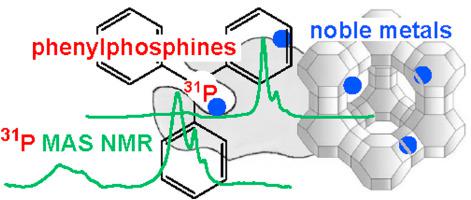Microporous and Mesoporous Materials ( IF 5.2 ) Pub Date : 2020-09-02 , DOI: 10.1016/j.micromeso.2020.110594 C. Rieg , D. Dittmann , Z. Li , A. Kurtz , I. Lorenz , D.P. Estes , M. Buchmeiser , M. Dyballa , M. Hunger

|
Different phosphines (PR3, R = phenyl, 4-methoxyphenyl) are demonstrated to be useful probe molecules for the spatial location and quantification of noble metal (NM) atoms within mesoporous and microporous support materials, such as silica A200, mesoporous SBA-15, and different zeolites Y. For this purpose, the high NMR sensitivity of 31P nuclei (spin I = ½, abundance of 100%) and the characteristic chemical shifts of phosphine complexes formed with noble metals were utilized. A straightforward method of physically mixing the reduced noble metal-containing catalysts with the solid phosphine powders and heating under well-defined conditions is shown. Complexation of triphenylphosphine (PPh3) and tris(4-methoxyphenyl)phosphine, P(PhOMe)3, with Pt, Rh, Pd, and Ru on open surfaces and in mesopores leads to characteristic 31P MAS NMR signals at δ = 33–41 ppm. Because of the different molecular diameters of PPh3 (0.72 nm) and P(PhOMe)3 (0.91 nm), adsorption of these two probe molecules allows to distinguish between noble metal atoms located at the outer surface of zeolite particles and those in secondary mesopores and in supercages of zeolites Y. For the first time this method enables the characterization of noble metals directly using probe molecules and 31P MAS NMR spectroscopy.
中文翻译:

通过与膦反应确定多孔载体中的贵金属位置
各种不同的膦(PR 3,R =苯基,4-甲氧基苯基)被证明是用于介孔和微孔载体材料(例如二氧化硅A200,中孔SBA-15)中贵金属(NM)原子的空间定位和定量的有用探针分子为此,利用了31 P核的高NMR灵敏度(旋转I =½,丰度为100%)和与贵金属形成的膦配合物的特征性化学位移。显示了将还原的含贵金属的催化剂与固体膦粉末物理混合并在明确的条件下加热的直接方法。三苯基膦(PPh 3的络合)和三(4-甲氧基苯基)膦P(PhOMe)3,在敞开的表面和中孔中带有Pt,Rh,Pd和Ru,导致δ = 33–41 ppm时具有特征性的31 P MAS NMR信号。由于PPh 3(0.72 nm)和P(PhOMe)3(0.91 nm)的分子直径不同,这两个探针分子的吸附可以区分位于沸石颗粒外表面的贵金属原子和次级中孔的贵金属原子。此方法首次使这种方法能够直接使用探针分子和31 P MAS NMR光谱直接表征贵金属。


























 京公网安备 11010802027423号
京公网安备 11010802027423号